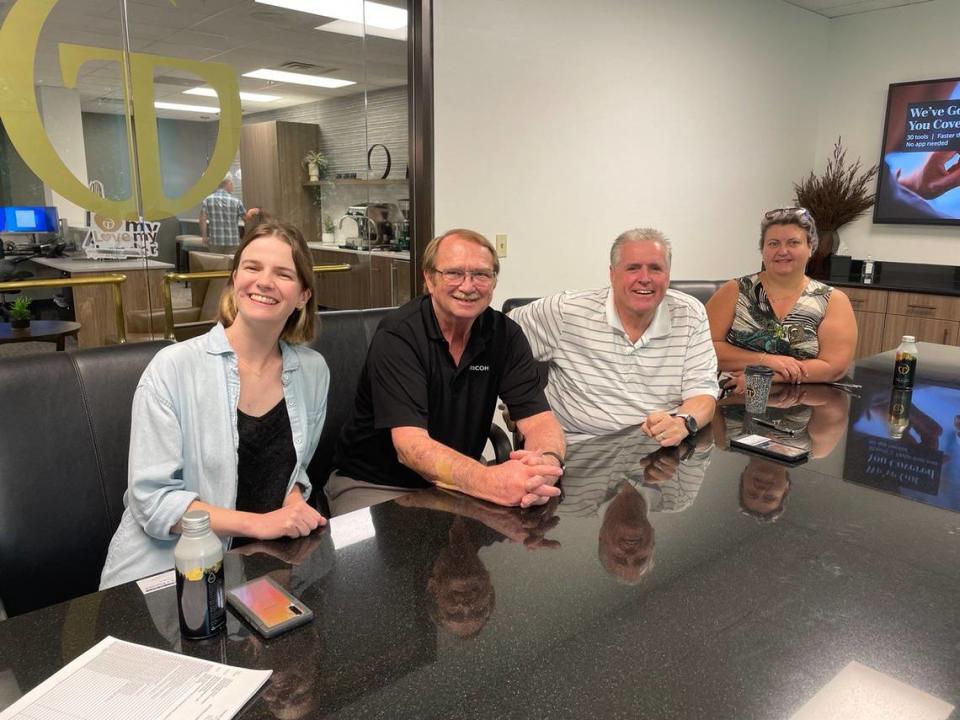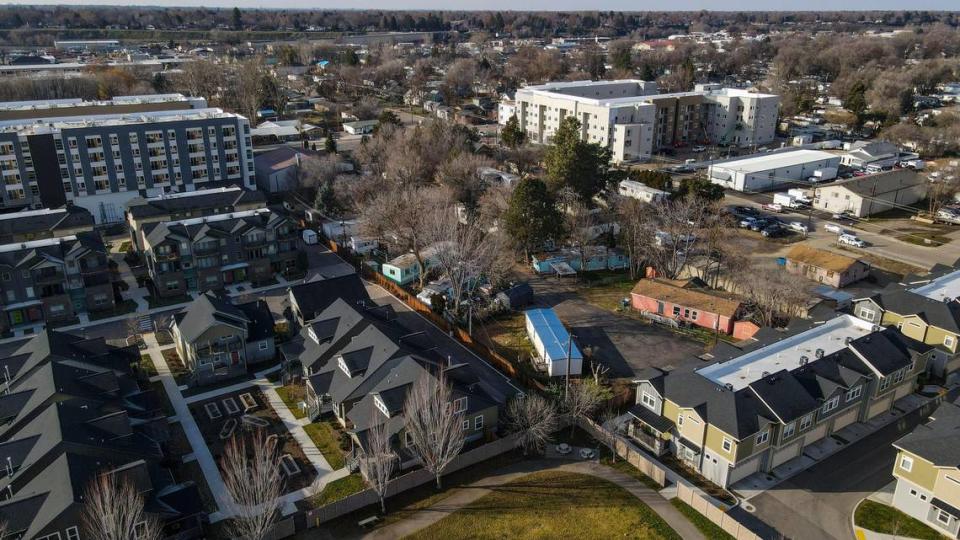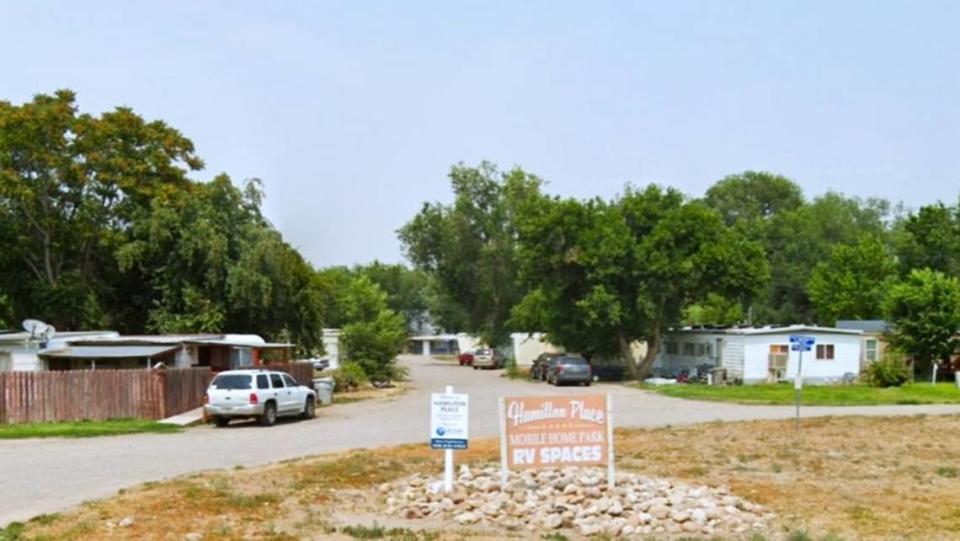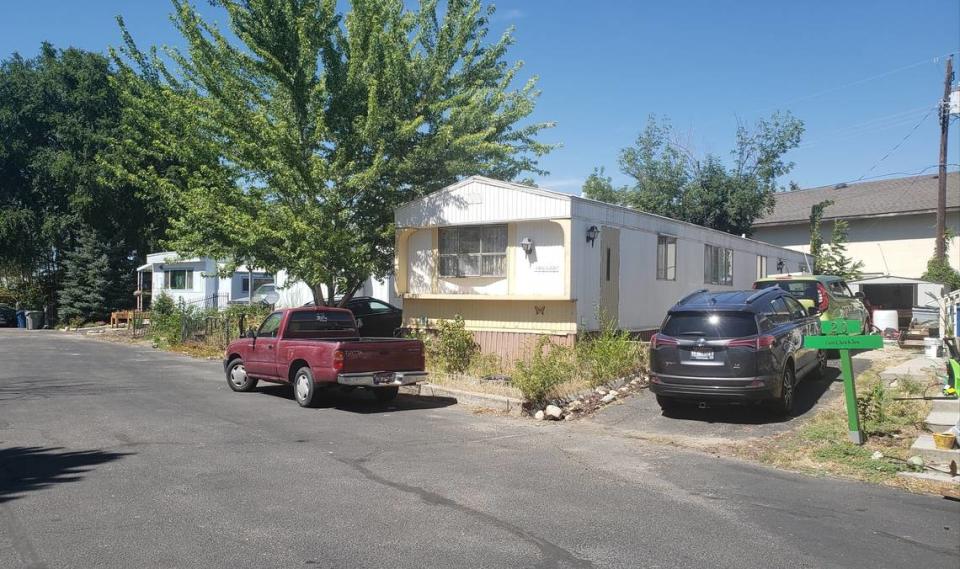Idaho’s most affordable homes are under fire, despite need for more. What’s happening?
Barry Shanahan wasn’t sure it would be possible to save his neighborhood.
The fate of Shanahan’s home at the Hamilton Place Mobile Home Park was teetering on the edge in February, when the owners decided to sell the nearly 11-acre property of aging trailers. Like many who live in manufactured homes in Southwest Idaho, Shanahan thought a real estate developer would scoop up the park to put in new houses and apartments — leaving them without the homes they bought.
“I just don’t think there would’ve been an investor who’d want to buy the park and then try to fix it up,” Shanahan said by phone. “It would be more advantageous for them to put a bunch of houses on it and sell it off … Make their money and go.”
But seven months after the owners announced they would move on, Shanahan and his neighbors are looking at a new future. They have banded together to buy the property so their 22 manufactured homes could stay put.
“We really decided, let’s save our community and make things better,” Shanahan said.

Hamilton Place, which is just south of Mountain Home, is one of three such resident-owned communities in Idaho — one in Garden City, the other in Caldwell — whose residents have secured their home sites by forming cooperatives to buy them. That is a model that can be replicated and exported through the state, says Leap Housing, a Boise-based nonprofit focused on housing affordability.
Leap helped all three communities buy their neighborhoods. On July 10, it submitted an application for a $14.1 million federal grant to expand the program and help protect nearly 230 homes. Leap works with ROC USA, a national nonprofit that promotes tenants’ purchases of ROCs, or resident-owned communities.
“This (grant) is the first of its kind,” said Holly Apsley, the ROC program manager at Leap. “These federal funds could really go a long way for several of these communities.”
The money would help subsidize the purchase of two additional manufactured-home parks in Mountain Home, one in Sandpoint, one on the western edge of Homedale, and one near Purple Sage Golf Course about 10 minutes from downtown Caldwell, according to the application. The parks are in predominantly rural areas, which Apsley said have disproportionately suffered from the housing shortage.
“Idaho is a uniquely rural state, highlighted by 84% of Idaho’s 199 cities having a population of under 5,000,” according to the application. “Many communities in rural Idaho do not have the tools nor the capital resources to preserve affordable housing.”
Manufactured homes, more commonly called mobile homes, have long been an affordable, and much cheaper, path to homeownership than stick-built homes provide for those with low incomes.
The average sale price of a new mobile home in Idaho was $168,500 in 2022, the highest of any state, according to Lending Tree, an online online lending marketplace. That compares with $340,000 for the median of all Elmore County homes sold in 2022, according to the Intermountain Multiple Listing Service — though that includes land, while Lending Tree’s price does not.
Most manufactured home owners own their homes but not the land underneath them. They lease it from the mobile home park’s landlord.
The median monthly lot rent can vary greatly between and within metro areas, including among Caldwell, Boise and Mountain Home, Apsley said. Lot rent can also vary greatly within cities. For instance,two manufactured homes for sale in Mountain Home that are less than a mile away from each other had rents listed Tuesday on Realtor.com of $295 and $445 per month.
Owners of all five parks that Leap now wants to save were planning to sell them but agreed to put those plans on hold while Leap applies for the grant. Leap says it would cost an average of $100,000 per lot to buy the land under the homes. Most of that would be paid by taxpayers: Leap’s application asks the federal government for $13.5 million to be spent on buying the parks. LEAP would borrow an additional $9.2 million from lenders.
The combination of renting the land and owning a home, Apsley said, can make it seem like residents have the worst of both.
“People are less flexible than other renters in the market but are still basically subject to that rental market,” Apsley said. “It puts homeowners in a bad spot, because it’s much harder to leave.”
While maintaining affordable housing has been an issue in the urban Boise area, it’s compounded even more in rural Idaho, said Zeb Moers, director of development for Leap.
“Rural Idaho isn’t seeing more units being built in proportion to urban areas,” Moers said in an email, “but the average home cost is rising at the same proportions.”
Home prices are getting higher while wages haven’t been able to keep up, Apsley said.
The median price for a home in Elmore County was nearly $195,000 in 2019 and $340,000 in 2022, a 74% increase in three years, according to the Intermountain Multiple Listing Service. It’s now $350,000.
The median household income in Elmore County was nearly $47,000 in 2019 and grew about 17% to $55,000 in 2022, the latest year for which data is available from the U.S. Census Bureau. A household would need to earn about $108,000 per year to afford Elmore County’s 2022 median $340,000, according to Zillow’s mortgage calculator.
As the shortage of affordable housing continues, real estate investors like Berkshire Hathaway have come to see manufactured home communities as more desirable, since tenant revenue can be more stable than traditional rentals and office space, which tanked during the pandemic, Aplsey said.
The best way to turn a profit for investors, she said, is to raise the rents.
“It became more publicized,” Apsley said. “(Real estate investment trusts) started turning their resources towards this investment class.”

Shaky footing for Idaho affordable housing
Many of the homes in Hamilton Place, and in parks across the state, were built before 1976 and require significant upgrades to bring them up to current standards before residents can move them to a new site, Shanahan said.
“There’s nowhere really to put (trailers), because they’re too old for the current standards,” he said. “They’d basically be abandoned.”
Moers said underinvestment by government programs has also played a role in the lack of rural affordable housing.
Section 515, a program run by the U.S. Department of Agriculture, lends funds to private and nonprofit organizations for affordable rental-housing development in rural areas, but it hasn’t been funded at scale for decades, Moers said. The program has been cut by more than 95% over the past few decades, he said.

When paired with an aging population, an uptick in wealthier Americans buying up housing supply for second homes in resort communities, and businesses struggling to fill jobs because of the lack of housing, rural communities have suffered a disproportionate impact from the housing shortage, Moers said.
“The entire state is experiencing the housing crunch, so this isn’t to say Boise … is doing just fine,” Moers said. “But there are different things at play in rural Idaho when it comes to demographic makeup, funding opportunities and commuting times when moving away from a job to find housing at affordable levels.”
Idaho is an outlier in its funding for affordable housing, Apsley said. Most other states in the West have some form of state funding that goes toward affordable housing, such as a coal trust-fund in Montana and Oregon’s Network for Oregon Affordable Housing.
The Idaho Legislature passed a bill in 2022 that created a $50 million fund to build 1,000 units of workforce housing, according to the Idaho Housing and Finance Association. But that money has all been allocated, with no more provided by lawmakers.
“In Idaho, we just really don’t have a lot of state sources to pull from,” Apsley said.
Challenges, and lessons, from Garden City
But while resident-owned communities can help stave off the loss of affordable housing, they are not without challenges.
The Hamilton Place Mobile Home Park had only seven months from the announcement that the owners were trying to sell the property to when the residents closed on the property on July 12.
“Everything moved fast,” Shanahan said. “It’s been a lot to organize… It’s a mini-miracle.”
A resident-owned community in Garden City, Buddy Dancer, nearly fell apart when residents of two communities bought and combined their parks in 2020, then the pandemic hit, according to Leap’s federal application.
“In the resulting confusion, the newly elected board was adrift, not sure how to access training or resources to be successful,” according to the application. “In the vacuum of information, rumors swirled that the community was in default or would be sold out from under them.”
The existing board members were burnt out and worried that nobody else would take their spots, according to the application. During a poorly attended annual meeting in 2021, residents turned to shouting.
In July 2022, Leap launched a “reorganization” of the community and went door to door, learning about how residents saw issues in their community and built connections with them, according to the application. On election day that year, 44% of residents showed up and elected seven residents to the board.

Nobody could have expected the pandemic, Apsley said, and the lack of in-person board meetings contributed to the confusion and difficulties that Buddy Dancer experienced.
But she said Leap learned just how important it was to have strong communication and to build relationships with the residents.
A “win-win” for accessible homeownership
Despite the difficulty of buying their own community, Shanahan said it was worth it to band together.
Hamilton Place saw an uptick in monthly payments to $475 per month from $385, Shanahan said. But this was mainly because the residents knew the community could make its loan payments on the $1.13 million purchase fairly easily, so they borrowed more than the actual cost of the land for sorely needed infrastructure improvements — such as preparing sites for more homes — after years of deferred maintenance, he said.
To create a resident-owned community, homeowners form a corporation or nonprofit that owns the park, and they elect a board of local residents. They own their homes but make monthly payments for things including upkeep, loans and infrastructure improvements such as repairing sidewalks.
The homes are also limited for at least 30 years to cost no more than 30% of income for households who make 80% or less of the area median income. In Mountain Home, 80% of the median household income in 2022 was just under $42,500, according to the U.S. Census Bureau.
Other protections include notice of rent increases, the right to purchase or sell their homes, and advance notice if the elected board chooses to sell or close the community, according to Leap’s application.
According to Apsley, Leap doesn’t loan money to the communities directly. Instead, Leap connects them with ROC USA Capital, which provides all the lending for the residents to buy their communities and extra money for any needed infrastructure upgrades.
“All costs are financed, no grants,” she said.
Though the residents receive loans from ROC USA Capital, the federal funding Leap applied for would go to subsidizing the purchase price of the communities.
Each household owns their own home independently and has a member share in the resident-owned corporation or nonprofit that owns the property, Apsley said. Residents pay a one-time membership fee of $100 that acts like a share of the company and allows them to run for the board and vote on decisions.
If a household wants to sell their home and move out, they’re responsible for setting a price and finding a buyer, she said. They would be refunded the $100, and the buyer would pay $100 to become a member. Each household gets one vote regardless of the number of household members.
The resale value of homes is limited by wage growth rather than market value, according to Bart Cochrane, the founder and CEO of Leap. This keeps homes affordable if home values outpace wage increases.
“No one can move us out or shut the place down as long as we keep up the taxes and all that,” Shanahan said. “It’s a win-win for everybody.”
Hamilton Place was wasting away year by year as the previous owners weren’t putting any money back into the park, Shanahan said. Under their new ownership, the community is already working to build it back up.
“It’s possible,” Shanahan said. “We’re a living testament that sometimes there are some positive things that can happen.”
Developers want to build 800+ new apartments in Boise. Some may be in your neighborhood
The apartments planned at the old Sears at Boise Towne Square still aren’t built. Now this
Harris Ranch has been under construction for nearly two decades. What’s happening next?
Home prices are up, but people are buying anyway. What’s going on with Boise real estate?

